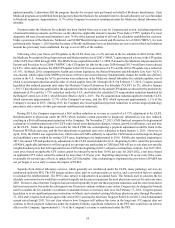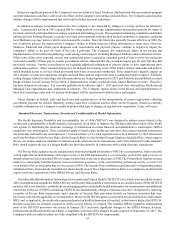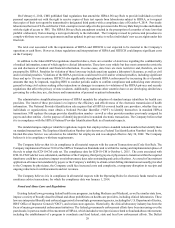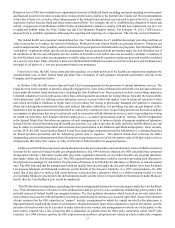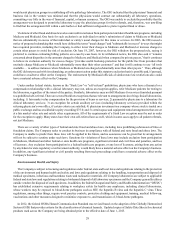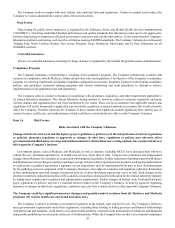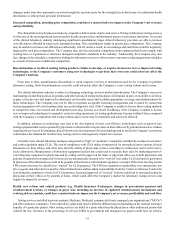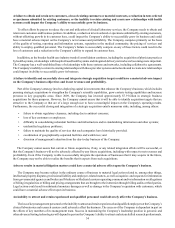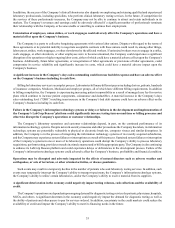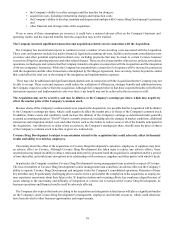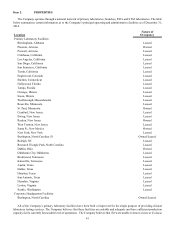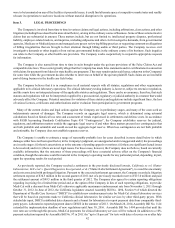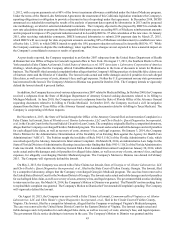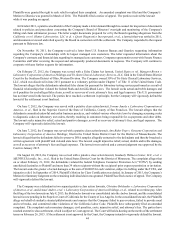LabCorp 2014 Annual Report Download - page 36
Download and view the complete annual report
Please find page 36 of the 2014 LabCorp annual report below. You can navigate through the pages in the report by either clicking on the pages listed below, or by using the keyword search tool below to find specific information within the annual report.34
A failure to obtain and retain new customers, a loss of existing customers or material contracts, a reduction in tests ordered
or specimens submitted by existing customers, or the inability to retain existing and create new relationships with health
systems could impact the Company’s ability to successfully grow its business.
To offset efforts by payers to reduce the cost and utilization of clinical laboratory services, the Company needs to obtain and
retain new customers and business partners. In addition, a reduction in tests ordered or specimens submitted by existing customers,
without offsetting growth in its customer base, could impact the Company’s ability to successfully grow its business and could
have a material adverse impact on the Company’s net revenues and profitability. The Company competes primarily on the basis
of the quality of testing, reporting and information systems, reputation in the medical community, the pricing of services and
ability to employ qualified personnel. The Company’s failure to successfully compete on any of these factors could result in the
loss of customers and a reduction in the Company’s ability to expand its customer base.
In addition, as the broader health care industry trend of consolidation continues, including the acquisition of physician practices
by health systems, relationships with hospital-based health systems and integrated delivery networks are becoming more important.
The Company has a well-established base of relationships with those systems and networks, including collaborative agreements.
The Company's inability to retain its existing relationships with those provider systems and networks and to create new relationships
could impact its ability to successfully grow its business.
A failure to identify and successfully close and integrate strategic acquisition targets could have a material adverse impact
on the Company's business objectives and its net revenues and profitability.
Part of the Company's strategy involves deploying capital in investments that enhance the Company's business, which includes
pursuing strategic acquisitions to strengthen the Company's scientific capabilities, grow esoteric testing capabilities and increase
presence in key geographic areas. Since 2009, the Company has invested approximately $7.9 billion in strategic business
acquisitions for these purposes. However, the Company cannot assure that it will be able to identify acquisition targets that are
attractive to the Company or that are of a large enough size to have a meaningful impact on the Company's operating results.
Furthermore, the successful closing and integration of a strategic acquisition entails numerous risks, including, among others:
• failure to obtain regulatory clearance, including due to antitrust concerns;
• loss of key customers or employees;
• difficulty in consolidating redundant facilities and infrastructure and in standardizing information and other systems;
• unidentified regulatory problems;
• failure to maintain the quality of services that such companies have historically provided;
• coordination of geographically-separated facilities and workforces; and
• diversion of management's attention from the day-to-day business of the Company.
The Company cannot assure that current or future acquisitions, if any, or any related integration efforts will be successful, or
that the Company's business will not be adversely affected by any future acquisitions, including with respect to net revenues and
profitability. Even if the Company is able to successfully integrate the operations of businesses that it may acquire in the future,
the Company may not be able to realize the benefits that it expects from such acquisitions.
Adverse results in material litigation matters could have a material adverse effect upon the Company’s business.
The Company may become subject in the ordinary course of business to material legal action related to, among other things,
intellectual property disputes, professional liability and employee-related matters, as well as inquiries and requests for information
from governmental agencies and bodies and Medicare or Medicaid carriers requesting comment and/or information on allegations
of billing irregularities or billing and pricing arrangements that are brought to their attention through billing audits or third parties.
Legal actions could result in substantial monetary damages as well as damage to the Company’s reputation with customers, which
could have a material adverse effect upon its business.
An inability to attract and retain experienced and qualified personnel could adversely affect the Company’s business.
The loss of key management personnel or the inability to attract and retain experienced and qualified employees at the Company’s
clinical laboratories and research centers could adversely affect the business. The success of the Company is dependent in part on
the efforts of key members of its management team. Success in maintaining the Company’s leadership position in genomic and
other advanced testing technologies will depend in part on the Company’s ability to attract and retain skilled research professionals.


